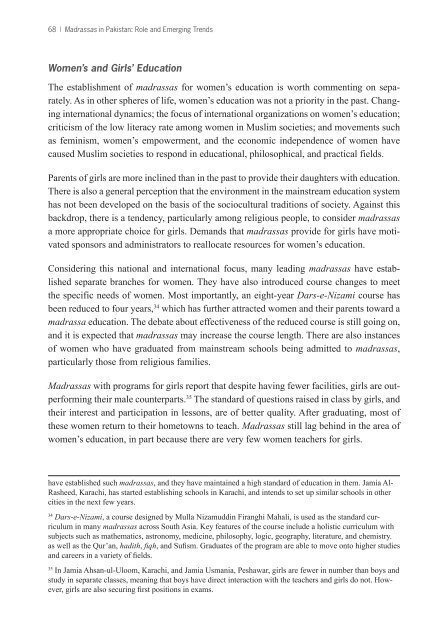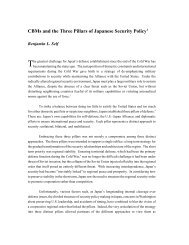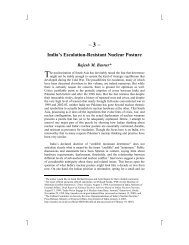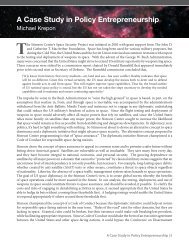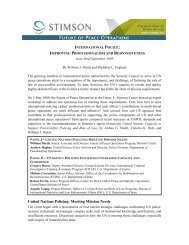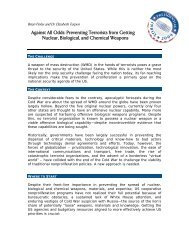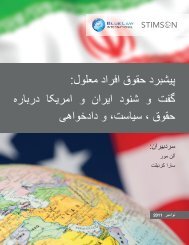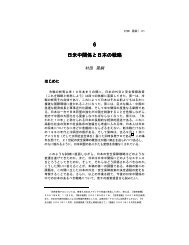Islam and Politics - The Stimson Center
Islam and Politics - The Stimson Center
Islam and Politics - The Stimson Center
Create successful ePaper yourself
Turn your PDF publications into a flip-book with our unique Google optimized e-Paper software.
68 | Madrassas in Pakistan: Role <strong>and</strong> Emerging Trends<br />
Women’s <strong>and</strong> Girls’ Education<br />
<strong>The</strong> establishment of madrassas for women’s education is worth commenting on separately.<br />
As in other spheres of life, women’s education was not a priority in the past. Changing<br />
international dynamics; the focus of international organizations on women’s education;<br />
criticism of the low literacy rate among women in Muslim societies; <strong>and</strong> movements such<br />
as feminism, women’s empowerment, <strong>and</strong> the economic independence of women have<br />
caused Muslim societies to respond in educational, philosophical, <strong>and</strong> practical fields.<br />
Parents of girls are more inclined than in the past to provide their daughters with education.<br />
<strong>The</strong>re is also a general perception that the environment in the mainstream education system<br />
has not been developed on the basis of the sociocultural traditions of society. Against this<br />
backdrop, there is a tendency, particularly among religious people, to consider madrassas<br />
a more appropriate choice for girls. Dem<strong>and</strong>s that madrassas provide for girls have motivated<br />
sponsors <strong>and</strong> administrators to reallocate resources for women’s education.<br />
Considering this national <strong>and</strong> international focus, many leading madrassas have established<br />
separate branches for women. <strong>The</strong>y have also introduced course changes to meet<br />
the specific needs of women. Most importantly, an eight-year Dars-e-Nizami course has<br />
been reduced to four years, 34 which has further attracted women <strong>and</strong> their parents toward a<br />
madrassa education. <strong>The</strong> debate about effectiveness of the reduced course is still going on,<br />
<strong>and</strong> it is expected that madrassas may increase the course length. <strong>The</strong>re are also instances<br />
of women who have graduated from mainstream schools being admitted to madrassas,<br />
particularly those from religious families.<br />
Madrassas with programs for girls report that despite having fewer facilities, girls are outperforming<br />
their male counterparts. 35 <strong>The</strong> st<strong>and</strong>ard of questions raised in class by girls, <strong>and</strong><br />
their interest <strong>and</strong> participation in lessons, are of better quality. After graduating, most of<br />
these women return to their hometowns to teach. Madrassas still lag behind in the area of<br />
women’s education, in part because there are very few women teachers for girls.<br />
have established such madrassas, <strong>and</strong> they have maintained a high st<strong>and</strong>ard of education in them. Jamia Al-<br />
Rasheed, Karachi, has started establishing schools in Karachi, <strong>and</strong> intends to set up similar schools in other<br />
cities in the next few years.<br />
34<br />
Dars-e-Nizami, a course designed by Mulla Nizamuddin Firanghi Mahali, is used as the st<strong>and</strong>ard curriculum<br />
in many madrassas across South Asia. Key features of the course include a holistic curriculum with<br />
subjects such as mathematics, astronomy, medicine, philosophy, logic, geography, literature, <strong>and</strong> chemistry.<br />
as well as the Qur’an, hadith, fiqh, <strong>and</strong> Sufism. Graduates of the program are able to move onto higher studies<br />
<strong>and</strong> careers in a variety of fields.<br />
35<br />
In Jamia Ahsan-ul-Uloom, Karachi, <strong>and</strong> Jamia Usmania, Peshawar, girls are fewer in number than boys <strong>and</strong><br />
study in separate classes, meaning that boys have direct interaction with the teachers <strong>and</strong> girls do not. However,<br />
girls are also securing first positions in exams.


